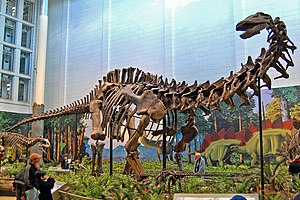Sauropoda
| Sauropods Temporal range: Late Triassic–Late Cretaceous, 210–66 Ma |
|
|---|---|
 |
|
| Mounted skeleton of Apatosaurus louisae, Carnegie Museum | |
| Scientific classification | |
| Kingdom: | Animalia |
| Phylum: | Chordata |
| Class: | Reptilia |
| Clade: | Dinosauria |
| Order: | Saurischia |
| Suborder: | †Sauropodomorpha |
| Clade: | †Anchisauria |
| Clade: |
†Sauropoda Marsh, 1878 |
| Subgroups | |
| Synonyms | |
|
†Opisthocoelia Owen, 1860 |
|
†Opisthocoelia Owen, 1860
†Cetiosauria Seeley, 1870
Sauropoda (/ˌsɔːrˈɒpədə/ or /ˌsɔːrəˈpoʊdə/), or the sauropods (/ˈsɔːrəˌpɒdz/; + , "lizard-footed"), are an infraorder of saurischian ("lizard-hipped") dinosaurs. They had very long necks, long tails, small heads (relative to the rest of their body), and four thick, pillar-like legs. They are notable for the enormous sizes attained by some species, and the group includes the largest animals to have ever lived on land. Well-known genera include Brachiosaurus, Diplodocus, Apatosaurus and Brontosaurus.
Sauropods first appeared in the late Triassic Period, where they somewhat resembled the closely related (and possibly ancestral) group "Prosauropoda". By the Late Jurassic (150 million years ago), sauropods had become widespread (especially the diplodocids and brachiosaurids). By the Late Cretaceous, those groups had mainly been replaced by the titanosaurs, which had a near-global distribution. However, as with all other non-avian dinosaurs alive at the time, the titanosaurs died out in the Cretaceous–Paleogene extinction event. Fossilised remains of sauropods have been found on every continent, including Antarctica.
...
Wikipedia
